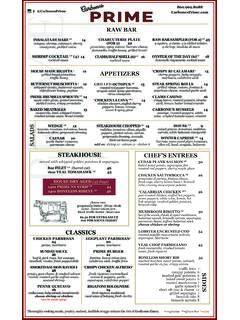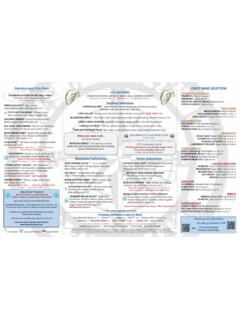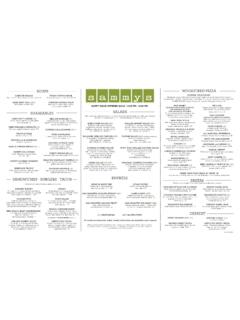Transcription of The NOVA Food Classification System
1 The NOVA Food Classification System The following reference was adapted from the NOVA Food Classification System , which was designed by Center for Epidemiological Studies in Health and Nutrition, School of Public Health, University of Sao Paulo, Brazil. NOVA helps people group foods according to the extent and purpose of the processing they undergo. Food processing as identified by NOVA involved physical, biological and chemical processes that occur after foods are separated from nature, and before they are consumed or used in the preparation of dishes and meals1.
2 GROUP 1: UNPROCESSED OR MINIMALLY PROCESSED FOODS. Unprocessed or Natural foods are obtained directly from plants or animals and do not undergo any alteration following their removal from nature. Minimally processed foods are natural foods that have been submitted to cleaning, removal of inedible or unwanted parts, fractioning, grinding, drying, fermentation, pasteurization, cooling, freezing, or other processes that may subtract part of the food, but which do not add oils, fats, sugar, salt or other substances to the original food. EXAMPLES. Natural, packaged, cut, chilled or frozen vegetables, nuts, peanuts, and other seeds fruits, potatoes, and other roots and tubers without salt or sugar bulk or packaged grains such as brown, white, fresh and dried herbs and spices parboiled and wholegrain rice, corn kernel, or wheat ( , oregano, pepper, thyme, berry cinnamon).
3 Fresh or pasteurized vegetable or fruit juices with no fresh and dried mushrooms and other added sugar or other substances fungi or algae grains of wheat, oats and other cereals fresh and dried herbs and spices grits, flakes and flours made from corn, wheat or oats, fresh, chilled or frozen meat, poultry, including those fortified with iron, folic acid or other fish and seafood, whole or in the form nutrients lost during processing of steaks, fillets and other cuts dried or fresh pasta, couscous, and polenta made fresh or pasteurized milk; yoghurt from water and the grits/flakes/flours described above without sugar eggs tea, herbal infusions lentils, chickpeas, beans, and other legumes coffee dried fruits tap, spring and mineral water 1 Quoted from: That article and the Brazilian Dietary Guidelines (from ), which also are informed by NOVA, were used to compile this reference document for use with your journals.
4 Food, Nutrition & Fitness I: The Digestion Journey Begins with Food Choices 1 of 4. Compiled in 2018 by EduChange with guidance from NUPENS, Sao Paulo. GROUP 2: OILS, FATS, SALT, AND SUGAR. Group 2 is also called Processed Culinary Ingredients. These are products extracted from natural foods or from nature by processes such as pressing, grinding, crushing, pulverizing, and refining. They are used in homes and restaurants to season and cook food and thus create varied and delicious dishes and meals of all types, including broths and soups, salads, pies, breads, cakes, sweets, and preserves.
5 Use oils, fats, salt, and sugar in small amounts for seasoning and cooking foods and to create culinary preparations. As long as they are used in moderation in culinary preparations based on natural or minimally processed foods, oils, fats, salt, and sugar contribute toward diverse and delicious diets without rendering them nutritionally unbalanced. EXAMPLES. oils made from seeds, nuts and fruits, to butter include soybeans, corn, oil palm , sunflower or olives white, brown and other types of sugar and lard molasses obtained from cane or beet honey extracted from honeycombs coconut fat syrup extracted from maple trees refined or coarse salt, mined or from seawater starches extracted from corn and other plants also any food combining 2 of these, such as salted butter'.
6 THE GOLDEN RULE: Always prefer natural or minimally processed foods and freshly made dishes and meals to ultra-processed foods.. Food, Nutrition & Fitness I: The Digestion Journey Begins with Food Choices 2 of 4. Compiled in 2018 by EduChange with guidance from NUPENS, Sao Paulo. GROUP 3: PROCESSED FOODS. Processed foods are products manufactured by industry with the use of salt, sugar, oil or other substances (Group 2) added to natural or minimally processed foods (Group 1) to preserve or to make them more palatable. They are derived directly from foods and are recognized as versions of the original foods.
7 They are usually consumed as a part of or as a side dish in culinary preparations made using natural or minimally processed foods. Most processed foods have two or three ingredients. EXAMPLES. canned or bottled legumes or canned fish, such as sardine and tuna, vegetables preserved in salt (brine) with or without added preservatives or vinegar, or by pickling tomato extract, pastes or salted, dried, smoked or cured meat or concentrates (with salt and/or sugar) fish fruits in sugar syrup (with or without coconut fat added antioxidants). beef jerky freshly-made cheeses bacon freshly-made (unpackaged) breads made of wheat flour, yeast, water and salt salted or sugared nuts and seeds fermented alcoholic beverages such as beer, alcoholic cider, and wine Food, Nutrition & Fitness I: The Digestion Journey Begins with Food Choices 3 of 4.
8 Compiled in 2018 by EduChange with guidance from NUPENS, Sao Paulo. GROUP 4: ULTRA-PROCESSED FOODS. Ultra-processed foods are industrial formulations made entirely or mostly from substances extracted from foods (oils, fats, sugar, starch, and proteins), derived from food constituents (hydrogenated fats and modified starch), or synthesized in laboratories from food substrates or other organic sources (flavor enhancers, colors, and several food additives used to make the product hyper-palatable). Manufacturing techniques include extrusion, moulding and preprocessing by frying.
9 Beverages may be ultra-processed. Group 1 foods are a small proportion of, or are even absent from, ultra-processed products. EXAMPLES. fatty, sweet, savory or salty packaged pre-prepared (packaged) meat, fish and snacks vegetables biscuits (cookies) pre-prepared pizza and pasta dishes ice creams and frozen desserts pre-prepared burgers, hot dogs, sausages chocolates, candies and pre-prepared poultry and fish nuggets'. confectionery in general and sticks'. cola, soda and other carbonated soft other animal products made from drinks remnants energy' and sports drinks packaged breads, hamburger and hot dog buns canned, packaged, dehydrated baked products made with ingredients (powdered)
10 And other instant' soups, such as hydrogenated vegetable fat, noodles, sauces, desserts, drink sugar, yeast, whey, emulsifiers, and mixes and seasonings other additives sweetened and flavored yogurts, breakfast cereals and bars including fruit yogurts dairy drinks, including chocolate milk infant formulas & drinks, and meal replacement shakes ( , slim fast'). sweetened juices pastries, cakes and cake mixes margarines and spreads distilled alcoholic beverages such as whisky, gin, rum, vodka, etc. Food, Nutrition & Fitness I: The Digestion Journey Begins with Food Choices 4 of 4.



